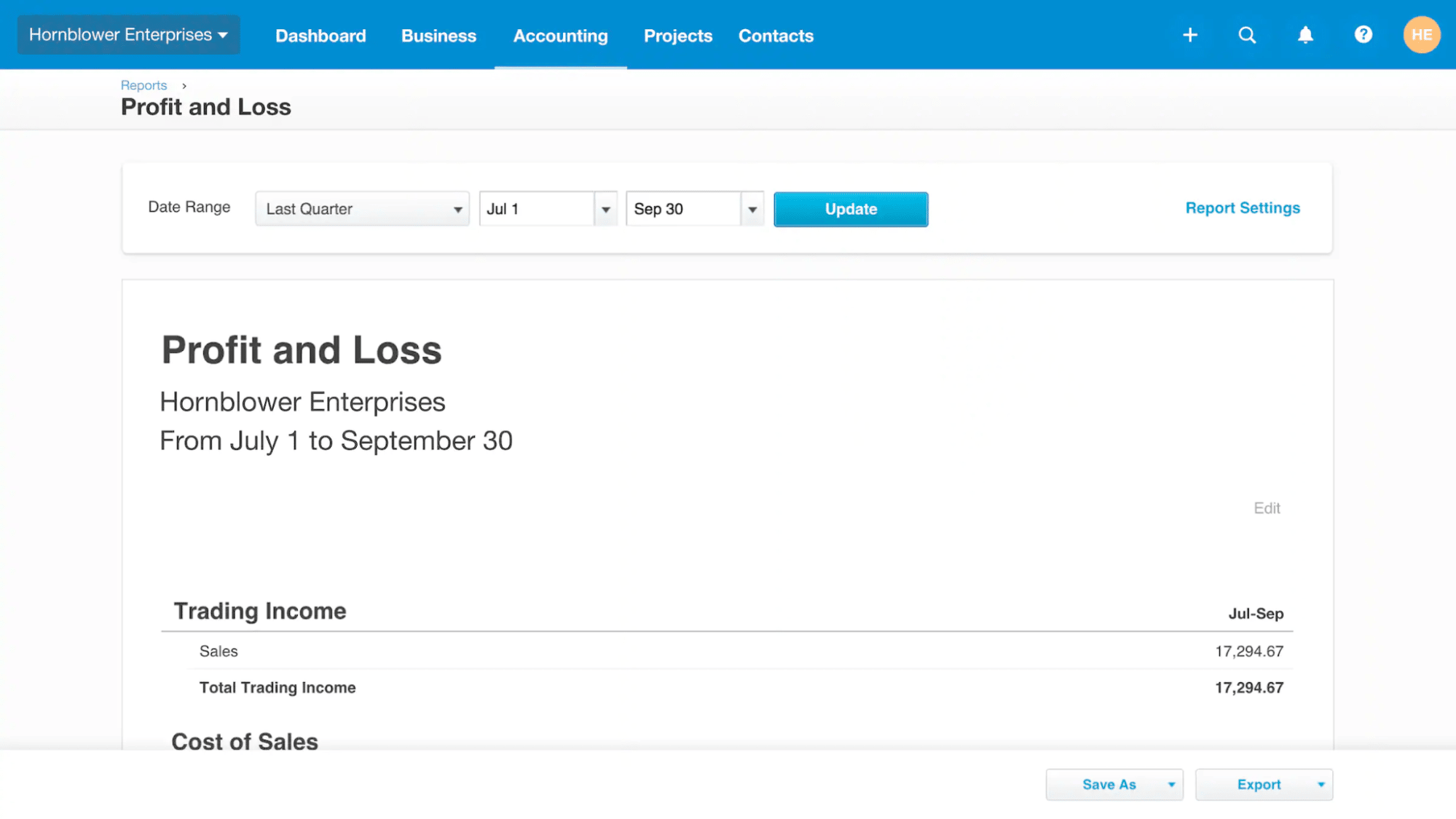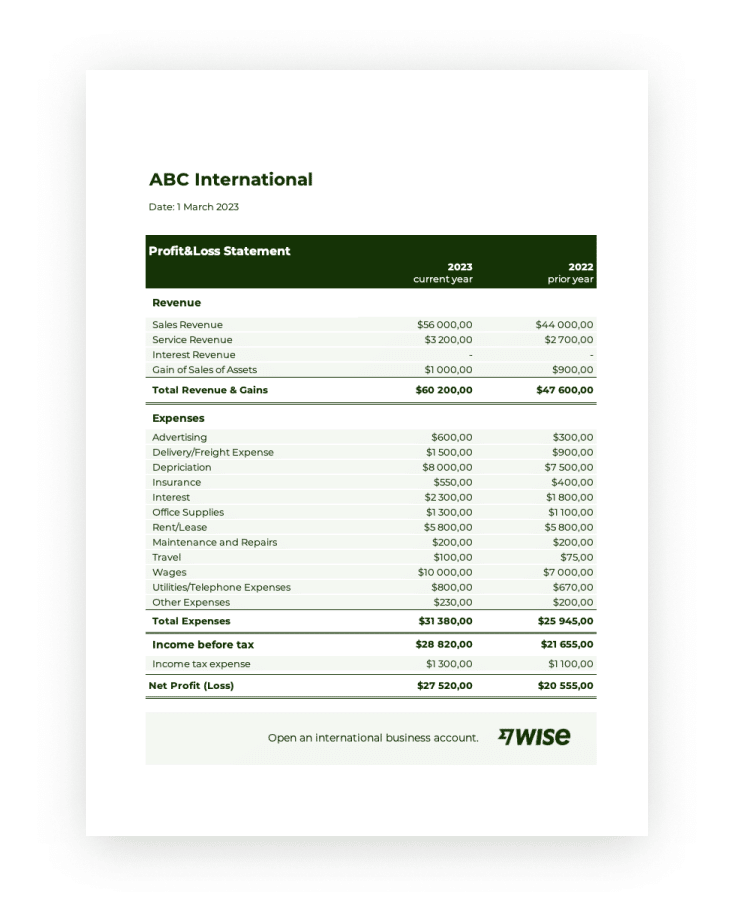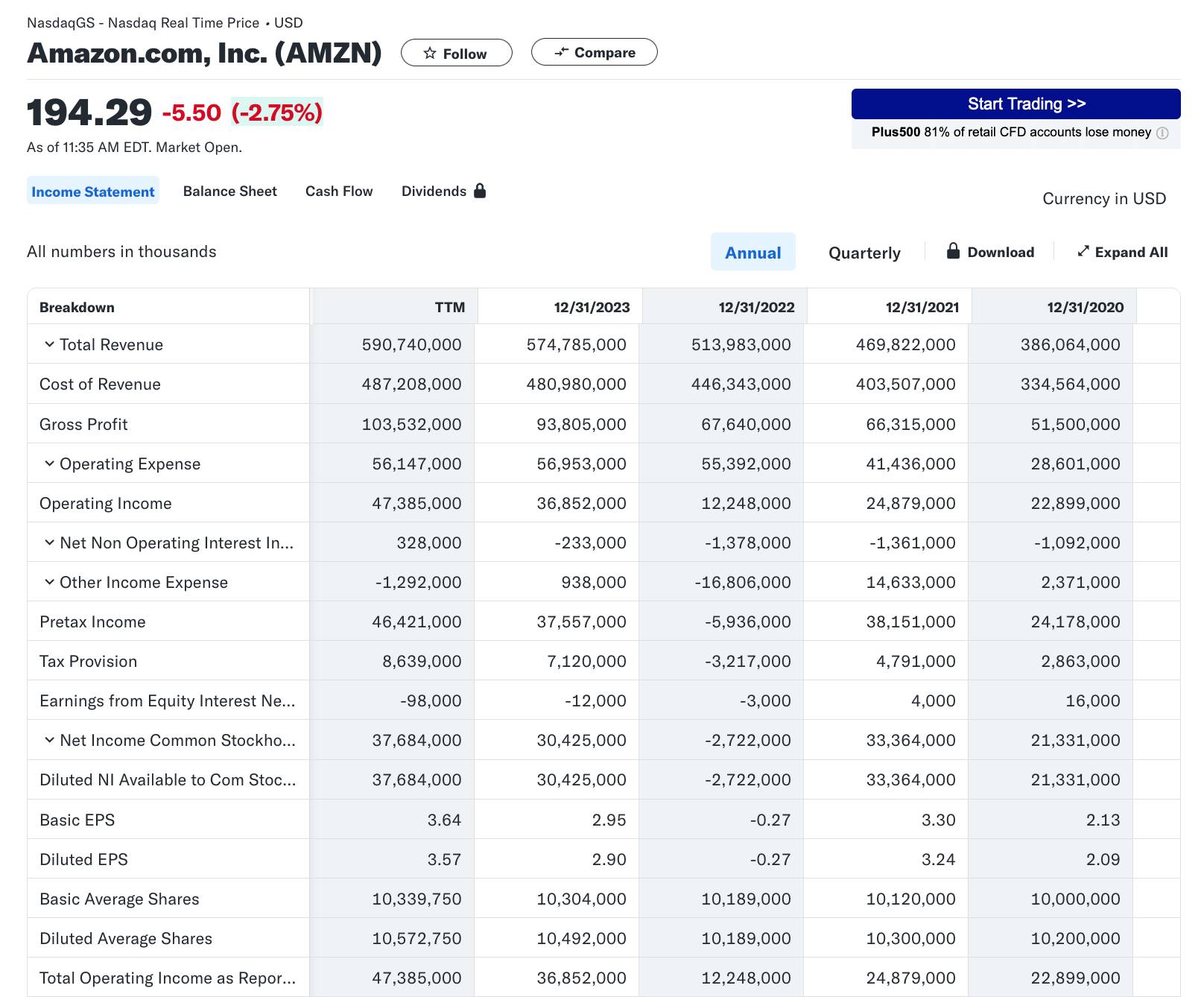Our view at Stack - Pipedrive is a robust CRM platform, offering automation, contact data collection, webhooks, AI-powered sales assistant, email communications, email marketing, and customisable sales pipeline workflows.
Effective financial management is the most critical part of running a successful small business, and it starts with understanding essential records like income statements.
In this article, you’ll learn what income statements are, why you need them and how to read one. We’ll also provide some simple income statement examples so you know what to expect when creating, sourcing or interpreting one for your business.
What is an income statement?
An income statement is a business record that summarizes a company’s revenues, costs and expenses over a specific period. It includes information like sales revenue, gross profit, operating expenses and net income.
Also known as a profit and loss (P&L) statement, the income statement is one of three high-level documents companies can use to report financial performance. The others are the cash flow statement and the balance sheet.
As a small business owner, you can use accounting software to create income statements for various purposes, including performance management and financial planning. These financial accounting tools automate the collection and organization of relevant data, saving time and ensuring accuracy.
Here’s what an income statement (labeled P&L in this instance) looks like in Xero, an accounting tool that integrates with Pipedrive:

Pipedrive is a sales customer relationship management (CRM) system that integrates with QuickBooks, Sage 100 and other popular accounting software.
Connecting accounting with contact management and sales solutions allows the tools to share data, making it easier to populate financial statements and report on business performance.
Income statement vs. balance sheet (and other related terms)
It’s easy to confuse “income statement” with similar financial terms since some are interchangeable and others have slightly different meanings.
These definitions will help you communicate with your accountant or use your accounting software efficiently:
| Term | What it means |
| Balance sheet |
A snapshot of a company’s financial position at a specific time, listing assets, liabilities and equity. |
| Cash flow statement |
A detailed analysis of a company’s cash flow (i.e., incoming and outgoing) categorized by operating, investing and financing activities. |
| Profit and loss statement (P&L) | Another term for the income statement, it highlights the profits or losses incurred over a specific reporting or accounting period. |
| Revenue statement | A form of income statement that focuses on the income generated from sales before deducting expenses. |
Financial management will become more complex as your business grows, with more terminology to understand. Outsourcing it to an accountant allows you to prioritize other critical business activities.
Recommended reading

Everything you need to know about small business management
3 reasons small business owners need income statements
By providing a clear and straightforward view of your company’s financial performance, income statements help you operate efficiently, set realistic goals and avoid legal penalties.
Here are the key use cases of an income statement.
1. Performance tracking
Incorporating income statements into your annual and quarterly business reviews (QBRs) is a simple way to check you’re on track to achieve high-level performance objectives.
By detailing total revenue, gross profit, operating income and net income, the records signal:
-
Your team’s efficiency and productivity
-
The effectiveness of your sales and marketing strategies
-
The strength of your overall business plan
Let’s say a tech company reviewed its latest income statement and discovered a significant increase in net income while operating costs remained steady and customer acquisition costs (CAC) decreased.
The company attributed the improvement to its new targeted digital marketing campaigns and customer outreach, so now they have data to back up its success.
2. Financial planning
Understanding the breakdown of the cost of goods sold (COGS), operating expenses and non-operating expenses allows you to keep tighter control over your budget.
It’ll identify areas where you can reduce or redirect spending to more critical parts of the business. You’ll then be able to create more accurate and realistic budgets, ensuring you allocate resources in ways that support growth and operational efficiency.
For example, if income statements show a consistent increase in gross profit but a decline in net income, that may indicate rising operational costs. You could renegotiate with suppliers and improve your bottom line if that’s the case.
Download your free sales invoice templates here
Use these invoice templates for Google and Microsoft to get started
3. Tax preparation
Keeping a clear but detailed record of all income and expenses makes it easier to prepare accurate tax returns and ensure you claim all deductible expenses. It also saves time during tax season and minimizes mistakes that could lead to audits or penalties.
For example, if your income statement shows all business-related travel expenses, you can claim them as tax deductions when filing your return.
It means you’ll stay compliant with regulations and avoid penalties. You could also reduce taxable income to increase profit. Use our free sales tax calculator to work out the amount of tax you would pay.
Who else uses income statements?
Income statements aren’t solely for small business owners. Other people and organizations who benefit from them include:
-
Financiers. Investors and lenders may use income statements (and other financial records) to assess your company’s financial health before providing funding.
-
Accountants. Accountants use income statements to prepare financial reports, conduct audits and offer strategic financial advice. They analyze the data to ensure accuracy in financial reporting and compliance with accounting standards.
-
Tax authorities. Tax authorities review income statements to verify reported income and deductible expenses for tax purposes. Accurate income statements ensure regulatory compliance and prevent auditing issues.
-
Managers. Internal managers use income statements to monitor team performance, manage budgets and make informed operational decisions. They also identify areas where the business can cut costs or invest more resources.
-
Potential buyers. If you’re looking to sell your business, potential buyers will scrutinize your income statements to evaluate financial performance and value. It helps them understand your business’ profitability and potential return on investment (ROI).
-
Consultants. Business consultants analyze income statements to provide insights and recommendations on improving financial performance. They help identify strengths, weaknesses and growth opportunities.
Ultimately, accurate income statements ensure everyone with a professional interest in your business’ finances has the information they need to do their jobs efficiently and effectively.
What goes into an income statement? The key components
Even if you use accounting software to generate income statements, understanding the key elements ensures you can interpret the data accurately when reading one.
Here’s what goes into a standard income statement:
| Metric | What it means |
| Revenue |
The total amount of money earned from sales of goods or services before deducting expenses. It’s often called the “top line” because it’s the first item listed. |
| Cost of goods sold (COGS) |
The direct cost of producing the goods sold by a company. It includes the cost of materials and labor used to create the product. |
| Gross profit | Calculated by subtracting COGS from total revenue. This figure represents a company’s profit after deducting the costs of making and selling its products. |
| Operating expenses | Costs of running the company that aren’t directly tied to producing goods or services. They can include rent, utilities, salaries and administrative expenses. Some people use the term “selling, general and administrative expenses” (SG&A). |
| Operating income | Also known as operating profit, it’s the gross profit minus operating expenses. It represents the profit from the company’s core business operations. |
| Net income | The income statement’s bottom line, calculated by subtracting all expenses from total revenue, including taxes and interest. It shows the company’s total profit or loss over a specific period. |
Here’s a simple income statement containing key components from Wise:

While some components are standard, income statements can vary depending on the business and industry. Some companies include more line items to create more detailed financial reports.
Here are some other metrics to consider including in your income statement:
-
Non-operating income and expenses. Revenues and costs unrelated to core business operations include interest income, dividends and one-off gains or losses from selling assets.
-
Earnings before interest and taxes (EBIT). An indicator of a company’s profitability that excludes interest and income tax expenses (i.e., pre-tax earnings). EBIT becomes EBITDA if you also exclude depreciation and amortization.
-
Depreciation and amortization. Non-cash expenses that reflect the ongoing or long-term cost of assets. Depreciation applies to physical assets (e.g., machinery), while amortization applies to intangible ones (e.g., patents).
-
Extraordinary items. Gains and losses that you don’t expect to happen regularly, like profits from discontinued products or costs from natural disasters.
-
Comprehensive income. Total income, including all changes in equity during a period other than those resulting from investments by owners and distributions to owners (e.g., dividends). It provides a broader and more complete view of financial performance.
Including extra metrics allows you to build a comprehensive record and tailor statements to different use cases.
For instance, an investor might expect detailed insights into non-operating income (e.g., from the sale of equipment) and expenses to understand all sources of revenue and costs. Creditors, meanwhile, often use EBIT to gauge a company’s ability to meet debt obligations.
Recommended reading

How to Fundraise with Pipedrive (and How We Raised Our $700k Seed Round)
Different types of income statements
Before we share some basic income statement examples, it’s helpful to know the formats you might encounter, which may present the same data differently.
As discussed, you can create simple or comprehensive income statements by tailoring the metrics you include.
There are also single-step and multi-step income statements to consider. These formats differ in the level of detail and the way they present operating and non-operating activities.
Single-step income statements
A single-step income statement is straightforward, summarizing revenues and expenses to calculate net income.
Here’s a basic example:
Total revenues: $100,000
Total expenses: $60,000
Net income: $40,000
The single-step format is simple and easy to read, making it suitable for small businesses or those with uncomplicated financial activities.
Multi-step income statements
A multi-step income statement provides a more detailed view by separating operating revenues and expenses from non-operating ones, providing breakdowns of each.
For example:
Revenue: $150,000
Cost of goods sold (COGS): $70,000
Gross profit: $80,000
Operating Expenses
Selling expenses: $20,000
Administrative expenses: $15,000
(Total operating expenses: $35,000)
Operating income: $45,000
Non-operating income
Interest income: $2,000
Non-operating expenses
Interest expense: $1,000
Net income: $46,000
These detailed categories provide deeper insights into where a company is performing well and what needs work. They help business owners make more informed decisions and focus their efforts.
Recommended reading

Annual sales: The ultimate guide
Income statement examples
Income statements can be daunting at first, especially if you have no financial analysis experience or aren’t used to working with numbers.
These basic income statement examples give you an idea of what to expect. You can copy them as free income statement templates for your company’s income and expenditure data.
Simple income statement example
| Business name | ABC Co. |
| Period | 01/01/2023 – 12/31/2023 |
| Revenue | $500,000 |
| COGS | $200,000 |
| Gross profit | $300,000 |
| Operating expenses: | |
| – Rent | $30,000 |
| – Utilities | $5,000 |
| – Salaries | $70,000 |
| – Administrative expenses | $10,000 |
| Total operating expenses | $115,000 |
| Net income | $185,000 |
Comprehensive income statement example:
| Business name | ABC Co. |
| Period | 01/01/2023 – 12/31/2023 |
| Revenue | $500,000 |
| COGS | $200,000 |
| Gross profit | $300,000 |
| Operating expenses: | |
| – Rent | $30,000 |
| – Utilities | $5,000 |
| – Salaries | $70,000 |
| – Administrative expenses | $10,000 |
| Total operating expenses | $115,000 |
| Operating income | $185,000 |
| Non-operating income and expenses: | |
| – Interest income | $2,000 |
| – One-off gain from asset sale | $5,000 |
| Total non-operating income | $7,000 |
| Earnings before interest and taxes (EBIT) | $192,000 |
| Depreciation and amortization | $10,000 |
| Net income | $182,000 |
For more inspiration, search for companies’ actual income statements. Publicly traded businesses often post them for shareholders, and many financial news sites cover them, too.
Here’s a glimpse of Amazon’s income statement on the Yahoo Finance website:

Given the size of most publicly traded companies and the complexity of their finances, expect these income statements to be highly detailed. As a small business owner or entrepreneur, yours will likely be more straightforward.
Recommended reading

What’s the difference between gross sales vs. net sales?
Income statement FAQs
Final thoughts
Understanding income statements and knowing when to use them makes you a more capable business owner.
It allows you to assess performance quickly, find improvement opportunities and have more productive conversations with accountants, investors or other entrepreneurs.
Even if you don’t create or manage your financial records, start reviewing your income statements regularly to monitor your financial health and make informed decisions about your company’s growth.
Download Your Guide to Sales Performance Measurement
The must-read guide for any sales manager trying to track, forecast and minimize risk. Learn how to scale sales with data-backed decisions.
If Pipedrive is of interest and you'd like more information, please do make contact or take a look in more detail here.
Credit: Original article published here.
